Jefferson
Active member
- Joined
- Apr 21, 2012
- Messages
- 190
- Reaction score
- 28
- Points
- 28
- Location
- Southwest Missouri
- Country
- United States
Note: I am currently in the process of compiling an account of all our herping since I last posted in July of 2020, and that post should be ready in the next 24 hours. In the meantime, Bethany has already written a good account of the largest trip we took during this period, along the Gulf Coast in late March, and she has graciously allowed me to copy and paste her account with pictures and commentary, while I will narrate and post pictures from all our other escapades since last summer. I hope you all enjoy, and the YouTube companion link is posted below. Thank you!
On March 26th, Nathan and I started off on a loop trip down through the southern states in search of unique native herpetofauna and flora. We spent six days exploring the outdoors and a final three days spending time with family in Tennessee. Nathan and I had a bet as to how many cottonmouths we would see during the trip through Louisiana, Mississippi, Florida, Alabama, and Georgia. I said we would find three, Nathan said we would see 30. We saw zero! Who takes a trip to the Deep South, wades through swamps, and doesn’t see a single cottonmouth OR alligator?! Instead, we came across rarities like striped newts, a Florida pine snake, Florida sand skinks, a gopher tortoise, Siren minima (newly described species), red-cockaded woodpeckers, and carnivorous plants! God’s creation is amazing and we are so grateful that we had the ability to see what we did. It is such a blessing not only to see those critters, but we are blessed with the health, freedom, and abilities to go out and find them.
Nathan drove through the night from Springfield, MO to meet up with a few friends and hike/herp at a Louisiana park. We met up with Tyler initially at the trailhead and started out towards the bog in search of Southern red salamanders and Gulf Coast mud salamanders. The first notable botanical find of the day was Florida red anise in bloom. I had never heard of this flowering understory tree that looked like a combination of rhododendron and witch hazel. I was quite astounded by their beauty. They were tough to photograph, though, because the blooms are shaded and nodding downwards. Brittany arrived later and caught up with us on the boardwalk trail. We had so much fun herping with our new friends, and I was especially intrigued with Brittany’s knowledge of insects and plants which she helped me identify. We spent about an hour and a half flipping logs with few significant herp finds. Finally, Brittany turned up a beautiful Southern red salamander which she named “Strawberry”. We snapped a few photos and headed on our merry way with Tyler to our next spot in Mississippi where we found our goal gulf coast mud salamander larvae and Valentine’s dusky salamanders. While in Louisiana, Brittany had given me some pointers on where to find some carnivorous plants that would be on our way to the Florida panhandle. One of the main things I was hoping to see on the trip were carnivorous plants, so I was excited by her news. So we said goodbye to Tyler and headed off to find those bug-eating, nutrient-deprived plants!

Southern red salamander (Pseudotriton ruber vioscai) nicknamed “Strawberry”

Gulf coast mud salamander (Pseudotriton montanus flavissimus)
While at a Mississippi nature preserve, Nathan and I ambled towards where we felt there might be a bog in the landscape with pitcher plants that Brittany told us about. On our way to our supposed bog location, we came upon a darling 90-some year-old lady named Betty sitting on a park bench along the footpath with her outdoor trail walker, watching the birds playfully fluttering to and fro in the pine forest. Even though we had a certain allotted time for finding plants, I much preferred talking with this sweet, chipper lady. We ended up seeing quite a few carnivorous plants, including my highest plant goal of the trip, sundew! Sundew is even smaller than I thought. Oh, but what an absolutely beautiful plant! The sappy dew droplets are what traps tiny insects where to get nutrients. These “dew” droplets glisten in the sun prettier than any man-made arrangement of diamonds.
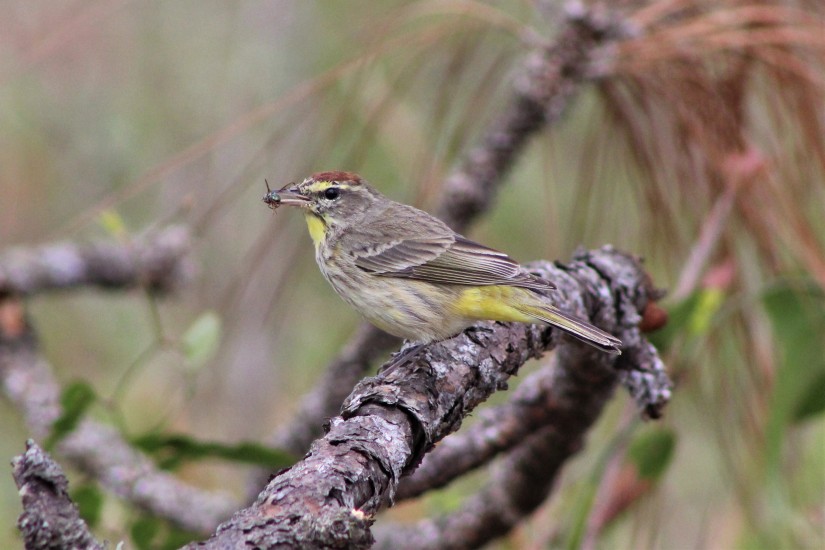 Palm warbler (I think) with insect
Palm warbler (I think) with insect

Bog sundew
After spending too much time with plants, birds, and old ladies, we had to hustle to the final location of the day to move onto more important things (ha!) such as kicking through the muck in a seepage bog in search of a dark swamp salamander called Siren minima, a newly described, secretive species. Running out of daylight, we kicked up a couple Siren minima in the muck but weren’t able to catch them, much less confirm their identification at the time. I caught a juvenile pig frog and propped it up onto a butterwort carnivorous plant (don’t worry, they don’t eat frogs) for a photo. Nathan said he saw a red-colored salamander that resembled a bog dwarf salamander, but again, was not able to capture or confirm I.D. due to the dimming daylight.

Juvenile pig frog (Lithobates grylio)
The next day we got up extra early (it wasn’t too hard to- our AirBNB the night before was sketchy, so we slept in our car instead!) to head back to our Siren minima location. Within a couple minutes, Nathan flipped a log that had a Southeastern slimy salamander underneath. Not too long after Nathan’s slimy salamander find, I kicked up the first Siren minima of the day. It was in a shallower area of muck. I kicked it up along with decayed leaves and mud, lost it, then saw it in a flash and quickly scooped it up in a handful of mud. This is what we do on our vacations, folks. Nathan and I chuckled to ourselves a few times at just how ridiculous what we were doing actually was--sifting mud on vacation. Siren minima “swim” though the muck and can disappear so easily, so they are pretty hard to catch. After taking photos and video, we released it and found about six more of the same species, along with a one adult and a handful of Southern red salamander larva.

Siren minima with apparent bite marks. Sirens are known to be territorial with each other.
We finished up at the seepage and drove to Southern Alabama to nab a few more lifer salamanders. Nathan found another beautifully speckled Southern red salamander and later, this teeny-tiny bog dwarf salamander that could fit on a penny! This species is associated with sphagnum moss. We later dip-netted some leaf packs in a stream for Escambia waterdogs. We netted two juveniles, along with bycatch of crayfish and tiny shrimp. That night we stayed at a really quaint AirBNB in Marianna, FL. Our hosts were exceedingly gracious in their hospitality! The walls were covered with the Michael’s prize-winning artwork, and June even cooked us breakfast in the morning. Nathan and I have really enjoyed staying at AirBNB’s in most of our travels. Despite just a couple of bad experiences (though not terrible), they are much better and far cheaper than hotels. Plus, you have access to the kitchen and laundry room most times.
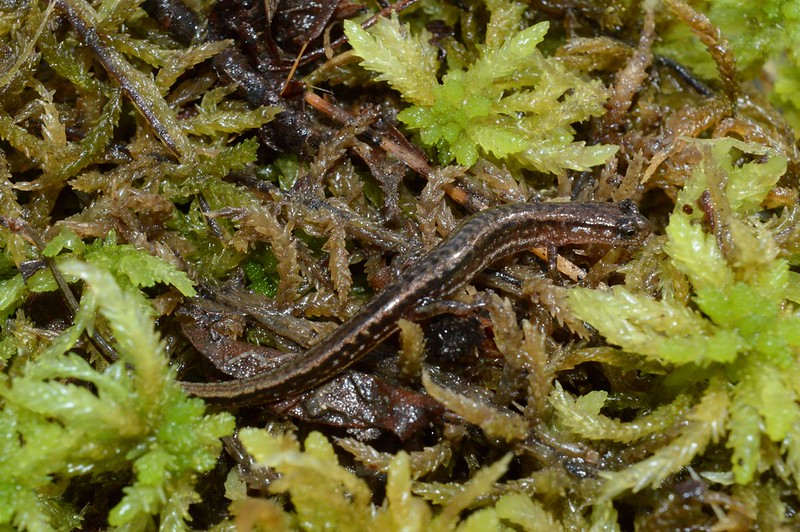
Bog dwarf salamander (Eurycea sphagnicola)

Bog dwarf salamander and Southern red salamander habitat

Escambia waterdog (Necturus monti)
The next morning we were unsuccessful at our locations for rusty mud salamander, one-toed amphiuma, Hillis’s dwarf, Coastal plains dwarf, and Apalachicola dusky salamander. So we moved on to the next spot where Nathan had a backup spot for Apalachicola duskies and potential gulf coast mud salamanders (we had already seen a gulf coast mud salamander but were hoping to see an adult). We hiked along a seepage bog for about an hour and a half, turning up slimy and three-lined salamanders. I love the color combination of black, white, and tan or copper, so these salamanders are always a welcome find. While I was photographing a three-lined salamander (photography is a good excuse to get out of having to flip rocks and logs) Nathan excitedly yelled across the bog to me that he had found two Apalachicola dusky salamanders. We snapped some photos and got some film, then head out of there!
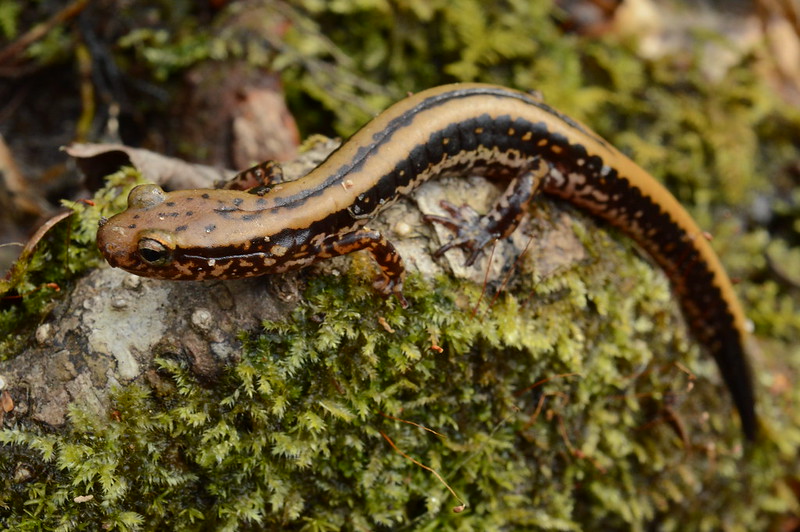
Three-lined salamander (Eurycea guttolineata)
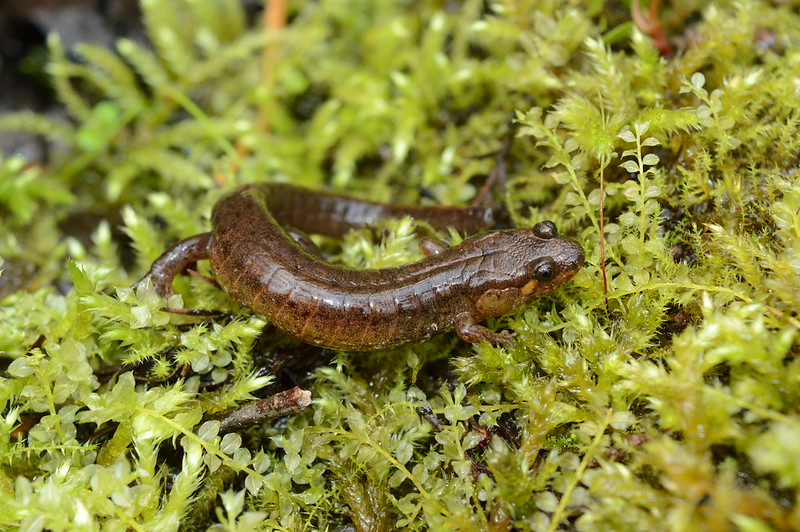
Apalachicola dusky salamander (Desmognathus apalachicolae)
The next morning we headed to a spot in a saw-palmetto pine woodland to search for a population of the southernmost Southern dusky (we’ve seen the ones further north in North Carolina). We cruised up a beautiful lifer corn snake whose copper-orange color was easily recognizable from a distance in the car. What a beauty of a snake! Hiking on the trail towards the Southern dusky salamanders, we realized just how hard-core native herpers have to be in Florida. You have to contend with the mosquitoes, gnats, heat, extremely brambly and overgrown thickets (make me miss the old-growth hardwood forests of Appalachia!), numerous venomous snake species, humidity, alligators, etc. Our trail, which was maintained by volunteers in theory only, was becoming more and more impassable with each step because the vegetation was so thick. Nathan and I decided that since we’ve already seen Southern dusky salamanders, it wasn’t worth it to continue our misery.

Corn snake basking in the morning sun (Pantherophis guttatus)

Corn snake
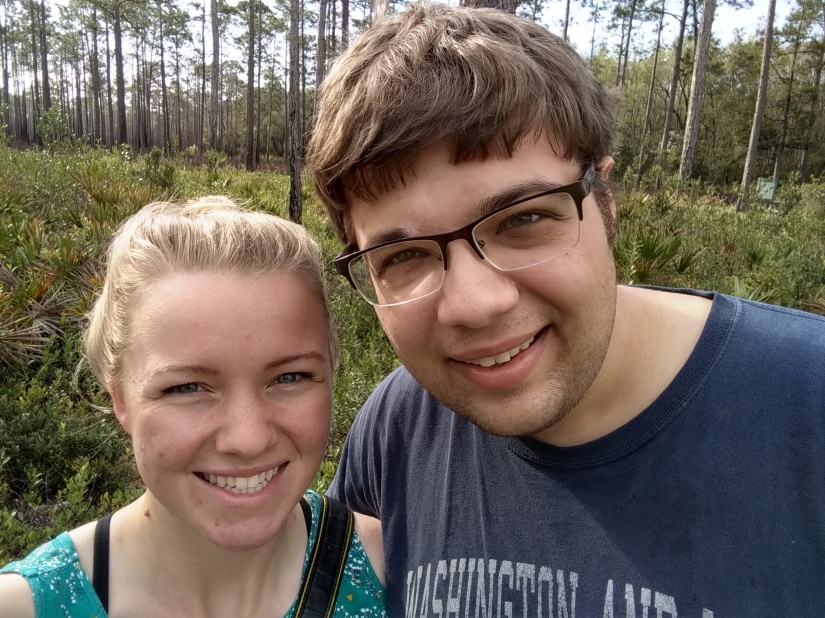
Nathan and me in a saw-palmetto longleaf pine woodland
Our next location is top-secret because we found a very rare species called the striped newt. That was probably my favorite place of the whole trip just because of the diverse plants and animals we saw there. We saw larval striped newts, probable gopher frog tadpoles, more sundew, zebra swallowtails, red-cockaded woodpeckers, and a very interesting display of bumblebees and honeybees around some blueberry bushes. Native bumblebees are compatible pollinators for blueberries. They are able to reach their mouths inside the flower for the nectar and in turn, pollinate each flower as the bumblebee flies from shrub to shrub. Honeybees, on the other hand, couldn’t reach inside the wild blueberry flowers so they have a sneaky and destructive way of accessing the nectar, “nectar robbing”. They chewed holes at the base of the flower to access the nectar without even bothering to pollinate! Sneaky! Nathan and I got to see all of this in action on two blueberry shrubs that had attracted bees. I was so happy to see this in action because I had only read about it over this winter in my Xerces Society books.
Our next stop for dwarf and greater sirens was not successful in terms of those goal species, but we saw many curious anoles, a watersnake, five-lined skink, and delightful honeybees and wasps on the blooming willow trees.
That night we road-cruised for snakes along the Gulf Coast and ended up finding this dusky pygmy rattlesnake! We also came across a deranged wild piglet. It came out of the brush running in circles! Nathan and I are still baffled as to why, but my guess is that it may have been bitten by a venomous snake and was trying to outrun the source of pain. Who knows.

Dusky pygmy rattlesnake
Continue to part 2/2, and be sure to read my forthcoming post on our other late 2020 and spring/summer 2021 herping!
On March 26th, Nathan and I started off on a loop trip down through the southern states in search of unique native herpetofauna and flora. We spent six days exploring the outdoors and a final three days spending time with family in Tennessee. Nathan and I had a bet as to how many cottonmouths we would see during the trip through Louisiana, Mississippi, Florida, Alabama, and Georgia. I said we would find three, Nathan said we would see 30. We saw zero! Who takes a trip to the Deep South, wades through swamps, and doesn’t see a single cottonmouth OR alligator?! Instead, we came across rarities like striped newts, a Florida pine snake, Florida sand skinks, a gopher tortoise, Siren minima (newly described species), red-cockaded woodpeckers, and carnivorous plants! God’s creation is amazing and we are so grateful that we had the ability to see what we did. It is such a blessing not only to see those critters, but we are blessed with the health, freedom, and abilities to go out and find them.
Nathan drove through the night from Springfield, MO to meet up with a few friends and hike/herp at a Louisiana park. We met up with Tyler initially at the trailhead and started out towards the bog in search of Southern red salamanders and Gulf Coast mud salamanders. The first notable botanical find of the day was Florida red anise in bloom. I had never heard of this flowering understory tree that looked like a combination of rhododendron and witch hazel. I was quite astounded by their beauty. They were tough to photograph, though, because the blooms are shaded and nodding downwards. Brittany arrived later and caught up with us on the boardwalk trail. We had so much fun herping with our new friends, and I was especially intrigued with Brittany’s knowledge of insects and plants which she helped me identify. We spent about an hour and a half flipping logs with few significant herp finds. Finally, Brittany turned up a beautiful Southern red salamander which she named “Strawberry”. We snapped a few photos and headed on our merry way with Tyler to our next spot in Mississippi where we found our goal gulf coast mud salamander larvae and Valentine’s dusky salamanders. While in Louisiana, Brittany had given me some pointers on where to find some carnivorous plants that would be on our way to the Florida panhandle. One of the main things I was hoping to see on the trip were carnivorous plants, so I was excited by her news. So we said goodbye to Tyler and headed off to find those bug-eating, nutrient-deprived plants!

Southern red salamander (Pseudotriton ruber vioscai) nicknamed “Strawberry”

Gulf coast mud salamander (Pseudotriton montanus flavissimus)
While at a Mississippi nature preserve, Nathan and I ambled towards where we felt there might be a bog in the landscape with pitcher plants that Brittany told us about. On our way to our supposed bog location, we came upon a darling 90-some year-old lady named Betty sitting on a park bench along the footpath with her outdoor trail walker, watching the birds playfully fluttering to and fro in the pine forest. Even though we had a certain allotted time for finding plants, I much preferred talking with this sweet, chipper lady. We ended up seeing quite a few carnivorous plants, including my highest plant goal of the trip, sundew! Sundew is even smaller than I thought. Oh, but what an absolutely beautiful plant! The sappy dew droplets are what traps tiny insects where to get nutrients. These “dew” droplets glisten in the sun prettier than any man-made arrangement of diamonds.


Bog sundew
After spending too much time with plants, birds, and old ladies, we had to hustle to the final location of the day to move onto more important things (ha!) such as kicking through the muck in a seepage bog in search of a dark swamp salamander called Siren minima, a newly described, secretive species. Running out of daylight, we kicked up a couple Siren minima in the muck but weren’t able to catch them, much less confirm their identification at the time. I caught a juvenile pig frog and propped it up onto a butterwort carnivorous plant (don’t worry, they don’t eat frogs) for a photo. Nathan said he saw a red-colored salamander that resembled a bog dwarf salamander, but again, was not able to capture or confirm I.D. due to the dimming daylight.

Juvenile pig frog (Lithobates grylio)
The next day we got up extra early (it wasn’t too hard to- our AirBNB the night before was sketchy, so we slept in our car instead!) to head back to our Siren minima location. Within a couple minutes, Nathan flipped a log that had a Southeastern slimy salamander underneath. Not too long after Nathan’s slimy salamander find, I kicked up the first Siren minima of the day. It was in a shallower area of muck. I kicked it up along with decayed leaves and mud, lost it, then saw it in a flash and quickly scooped it up in a handful of mud. This is what we do on our vacations, folks. Nathan and I chuckled to ourselves a few times at just how ridiculous what we were doing actually was--sifting mud on vacation. Siren minima “swim” though the muck and can disappear so easily, so they are pretty hard to catch. After taking photos and video, we released it and found about six more of the same species, along with a one adult and a handful of Southern red salamander larva.

Siren minima with apparent bite marks. Sirens are known to be territorial with each other.
We finished up at the seepage and drove to Southern Alabama to nab a few more lifer salamanders. Nathan found another beautifully speckled Southern red salamander and later, this teeny-tiny bog dwarf salamander that could fit on a penny! This species is associated with sphagnum moss. We later dip-netted some leaf packs in a stream for Escambia waterdogs. We netted two juveniles, along with bycatch of crayfish and tiny shrimp. That night we stayed at a really quaint AirBNB in Marianna, FL. Our hosts were exceedingly gracious in their hospitality! The walls were covered with the Michael’s prize-winning artwork, and June even cooked us breakfast in the morning. Nathan and I have really enjoyed staying at AirBNB’s in most of our travels. Despite just a couple of bad experiences (though not terrible), they are much better and far cheaper than hotels. Plus, you have access to the kitchen and laundry room most times.

Bog dwarf salamander (Eurycea sphagnicola)

Bog dwarf salamander and Southern red salamander habitat

Escambia waterdog (Necturus monti)
The next morning we were unsuccessful at our locations for rusty mud salamander, one-toed amphiuma, Hillis’s dwarf, Coastal plains dwarf, and Apalachicola dusky salamander. So we moved on to the next spot where Nathan had a backup spot for Apalachicola duskies and potential gulf coast mud salamanders (we had already seen a gulf coast mud salamander but were hoping to see an adult). We hiked along a seepage bog for about an hour and a half, turning up slimy and three-lined salamanders. I love the color combination of black, white, and tan or copper, so these salamanders are always a welcome find. While I was photographing a three-lined salamander (photography is a good excuse to get out of having to flip rocks and logs) Nathan excitedly yelled across the bog to me that he had found two Apalachicola dusky salamanders. We snapped some photos and got some film, then head out of there!

Three-lined salamander (Eurycea guttolineata)

Apalachicola dusky salamander (Desmognathus apalachicolae)
The next morning we headed to a spot in a saw-palmetto pine woodland to search for a population of the southernmost Southern dusky (we’ve seen the ones further north in North Carolina). We cruised up a beautiful lifer corn snake whose copper-orange color was easily recognizable from a distance in the car. What a beauty of a snake! Hiking on the trail towards the Southern dusky salamanders, we realized just how hard-core native herpers have to be in Florida. You have to contend with the mosquitoes, gnats, heat, extremely brambly and overgrown thickets (make me miss the old-growth hardwood forests of Appalachia!), numerous venomous snake species, humidity, alligators, etc. Our trail, which was maintained by volunteers in theory only, was becoming more and more impassable with each step because the vegetation was so thick. Nathan and I decided that since we’ve already seen Southern dusky salamanders, it wasn’t worth it to continue our misery.

Corn snake basking in the morning sun (Pantherophis guttatus)

Corn snake

Nathan and me in a saw-palmetto longleaf pine woodland
Our next location is top-secret because we found a very rare species called the striped newt. That was probably my favorite place of the whole trip just because of the diverse plants and animals we saw there. We saw larval striped newts, probable gopher frog tadpoles, more sundew, zebra swallowtails, red-cockaded woodpeckers, and a very interesting display of bumblebees and honeybees around some blueberry bushes. Native bumblebees are compatible pollinators for blueberries. They are able to reach their mouths inside the flower for the nectar and in turn, pollinate each flower as the bumblebee flies from shrub to shrub. Honeybees, on the other hand, couldn’t reach inside the wild blueberry flowers so they have a sneaky and destructive way of accessing the nectar, “nectar robbing”. They chewed holes at the base of the flower to access the nectar without even bothering to pollinate! Sneaky! Nathan and I got to see all of this in action on two blueberry shrubs that had attracted bees. I was so happy to see this in action because I had only read about it over this winter in my Xerces Society books.
Our next stop for dwarf and greater sirens was not successful in terms of those goal species, but we saw many curious anoles, a watersnake, five-lined skink, and delightful honeybees and wasps on the blooming willow trees.
That night we road-cruised for snakes along the Gulf Coast and ended up finding this dusky pygmy rattlesnake! We also came across a deranged wild piglet. It came out of the brush running in circles! Nathan and I are still baffled as to why, but my guess is that it may have been bitten by a venomous snake and was trying to outrun the source of pain. Who knows.

Dusky pygmy rattlesnake
Continue to part 2/2, and be sure to read my forthcoming post on our other late 2020 and spring/summer 2021 herping!
